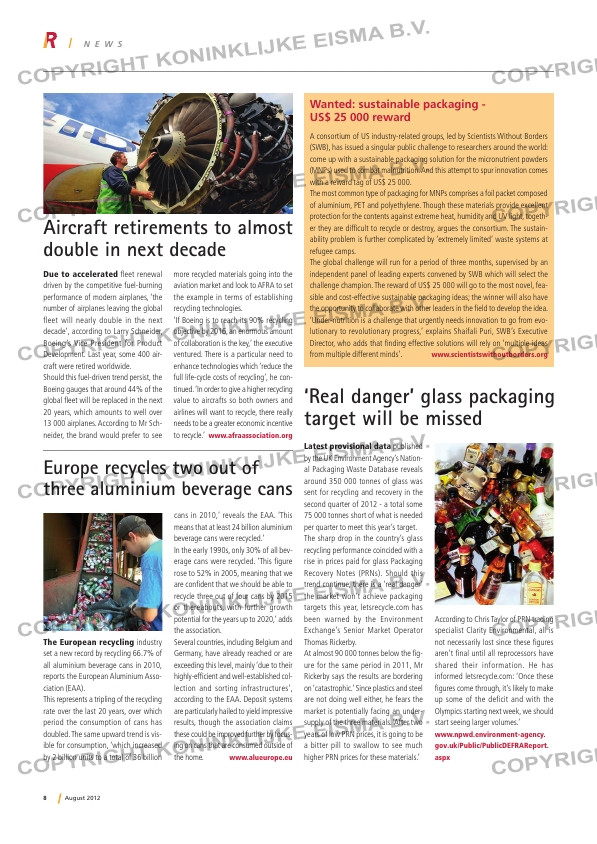Page 8 from: August 2012

8 August 2012
N E W S
Due to accelerated fleet renewal
driven by the competitive fuel-burning
performance of modern airplanes, ‘the
number of airplanes leaving the global
fleet will nearly double in the next
decade’, according to Larry Schneider,
Boeing’s Vice President for Product
Development. Last year, some 400 air-
craft were retired worldwide.
Should this fuel-driven trend persist, the
Boeing gauges that around 44% of the
global fleet will be replaced in the next
20 years, which amounts to well over
13 000 airplanes. According to Mr Sch-
neider, the brand would prefer to see
more recycled materials going into the
aviation market and look to AFRA to set
the example in terms of establishing
recycling technologies.
‘If Boeing is to reach its 90% recycling
objective by 2016, an enormous amount
of collaboration is the key,’ the executive
ventured. There is a particular need to
enhance technologies which ‘reduce the
full life-cycle costs of recycling’, he con-
tinued. ‘In order to give a higher recycling
value to aircrafts so both owners and
airlines will want to recycle, there really
needs to be a greater economic incentive
to recycle.’ www.afraassociation.org
Aircraft retirements to almost
double in next decade
Wanted: sustainable packaging –
US$ 25 000 reward
A consortium of US industry-related groups, led by Scientists Without Borders
(SWB), has issued a singular public challenge to researchers around the world:
come up with a sustainable packaging solution for the micronutrient powders
(MNPs) used to combat malnutrition. And this attempt to spur innovation comes
with a reward tag of US$ 25 000.
The most common type of packaging for MNPs comprises a foil packet composed
of aluminium, PET and polyethylene. Though these materials provide excellent
protection for the contents against extreme heat, humidity and UV light, togeth-
er they are difficult to recycle or destroy, argues the consortium. The sustain-
ability problem is further complicated by ‘extremely limited’ waste systems at
refugee camps.
The global challenge will run for a period of three months, supervised by an
independent panel of leading experts convened by SWB which will select the
challenge champion. The reward of US$ 25 000 will go to the most novel, fea-
sible and cost-effective sustainable packaging ideas; the winner will also have
the opportunity to collaborate with other leaders in the field to develop the idea.
‘Under-nutrition is a challenge that urgently needs innovation to go from evo-
lutionary to revolutionary progress,’ explains Shaifali Puri, SWB’s Executive
Director, who adds that finding effective solutions will rely on ‘multiple ideas
from multiple different minds’. www.scientistswithoutborders.org
Latest provisional data published
by the UK Environment Agency’s Nation-
al Packaging Waste Database reveals
around 350 000 tonnes of glass was
sent for recycling and recovery in the
second quarter of 2012 – a total some
75 000 tonnes short of what is needed
per quarter to meet this year’s target.
The sharp drop in the country’s glass
recycling performance coincided with a
rise in prices paid for glass Packaging
Recovery Notes (PRNs). Should this
trend continue, there is a ‘real danger’
the market won’t achieve packaging
targets this year, letsrecycle.com has
been warned by the Environment
Exchange’s Senior Market Operator
Thomas Rickerby.
At almost 90 000 tonnes below the fig-
ure for the same period in 2011, Mr
Rickerby says the results are bordering
on ‘catastrophic.’ Since plastics and steel
are not doing well either, he fears the
market is potentially facing an under-
supply of the three materials. ‘After two
years of low PRN prices, it is going to be
a bitter pill to swallow to see much
higher PRN prices for these materials.’
According to Chris Taylor of PRN trading
specialist Clarity Environmental, all is
not necessarily lost since these figures
aren’t final until all reprocessors have
shared their information. He has
informed letsrecycle.com: ‘Once these
figures come through, it’s likely to make
up some of the deficit and with the
Olympics starting next week, we should
start seeing larger volumes.’
www.npwd.environment-agency.
gov.uk/Public/PublicDEFRAReport.
aspx
‘Real danger’ glass packaging
target will be missed
The European recycling industry
set a new record by recycling 66.7% of
all aluminium beverage cans in 2010,
reports the European Aluminium Asso-
ciation (EAA).
This represents a tripling of the recycling
rate over the last 20 years, over which
period the consumption of cans has
doubled. The same upward trend is vis-
ible for consumption, ‘which increased
by 2 billion units to a total of 36 billion
cans in 2010,’ reveals the EAA. ‘This
means that at least 24 billion aluminium
beverage cans were recycled.’
In the early 1990s, only 30% of all bev-
erage cans were recycled. ‘This figure
rose to 52% in 2005, meaning that we
are confident that we should be able to
recycle three out of four cans by 2015
or thereabouts, with further growth
potential for the years up to 2020,’ adds
the association.
Several countries, including Belgium and
Germany, have already reached or are
exceeding this level, mainly ‘due to their
highly-efficient and well-established col-
lection and sorting infrastructures’,
according to the EAA. Deposit systems
are particularly hailed to yield impressive
results, though the association claims
these could be improved further by focus-
ing on cans that are consumed outside of
the home. www.alueurope.eu
Europe recycles two out of
three aluminium beverage cans
RI_6-News.indd 8 02-08-12 15:15



